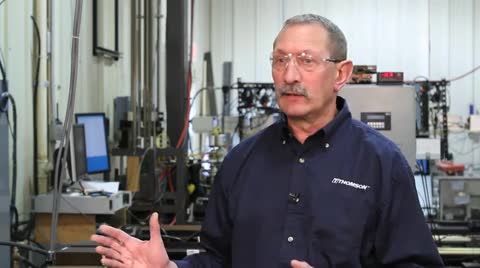
Al Wroblaski, Thomson Linear Actuator Product Line Manager, demonstrates the advantages of Industrial Linear Actuators over hydraulic systems. He discusses issues such as contamination, temperature, safety, economy, maintenance, integration and system size. Also included is a demonstration of application data acquisition techniques and their use in optimizing customer applications.
A Thomson linear actuator is a linear device that provides thrust and is a combination of pre-designed components that have a motor, a gearbox and a lead screw.
A hydraulic system is a fluid powered device that is energized by the movement and pressure of fluid in multiple directions. Because it's a fluid device and it is self contained with seals, it will inherently have contamination in leaks. So one of the major advantages of a electromechanical device today that's very popular is the green effect. There's no contamination.
A hydraulic cylinder also requires power and it requires pressure to the hoses to maintain a load. An industrial linear actuator does not.
Once you fix a position on an actuator within its rated load and it will hold it indefinitely without the use of power. You can cut the wires on an industrial linear actuator, and the load will still be held.
Independent of those features, industrial linear actuators are designed to work in very cold environments. Hydraulic systems, however, have issues when it gets down below 30 degrees.
Also, industrial linear actuators are designed to be maintenance free for the life of the product. That isn't true with hydraulics. Hydraulics typically have to go through routine maintenance.
In this facility, we will customize units specific to customers' requirements and then we will test them. We also test new designs and new and advanced components that we will integrate into our actuators.
Using a portable testing device with a load cell pin and a data acquisition system, we can determine the load, the voltage and the current draw on the actuator. On the screen, you can see the load changing, the voltage dropping, in rush current. We can use this setup to determine if the load that they gave us for the original specification is correct. The current draw, the voltage and then we can optimize the actuator for them to fit this application better.
Another major advantage of linear actuators. Because they are controlled by electricity as opposed to fluid power, it's much easier to put feedback on them and to integrate them with the type of micro processes that are readily available today. So that's a real advantage and that's helping to spur the growth.
A typical hydraulic setup will consist of one or two hydraulic cylinders with hoses and to support the pressure and to achieve the linear motion that's required, you have to have fluid power fluid pressure in both directions. In order to achieve that, you have to have a motor, a reservoir and a pump that supplies that pressure along with hoses. To control that pressure, you typically have to have a directional control and valve controls which all head back into a central control box. Every hydraulic cylinder will eventually leak everything you see here.
All the equipment required for a hydraulic system can be replaced by an industrial linear actuator, making it a very simple, compact system to put together.
